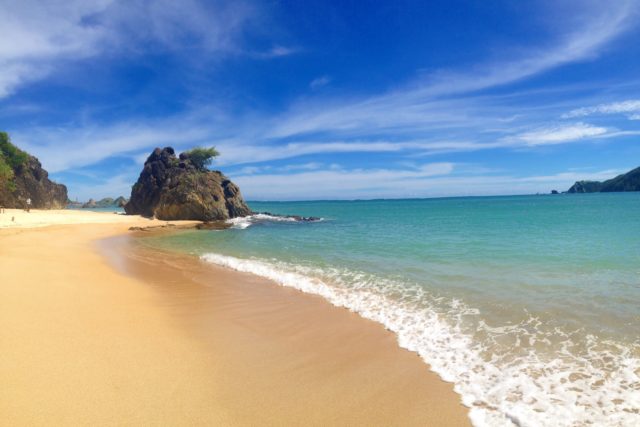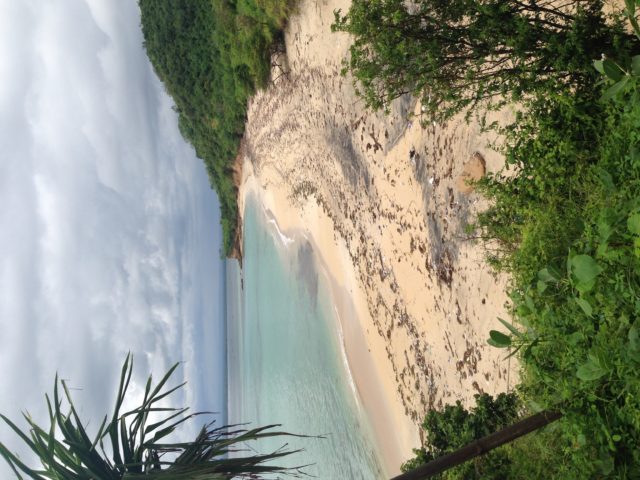29 January 2017
Fifty-plus dives and I can safely say that this was the most disappointing dive of my life.
Let me backtrack. For over a year I’ve been looking forward to visiting the Gili Islands of Lombok, Indonesia. I’d had several friends and colleagues recommend them as a great dive hub, so when I finally planned out my travel itinerary, they were first on the list. Now to be fair, the more time I spent in Indonesia, the clearer it became that the Gilis weren’t exactly undiscovered islands anymore. In the past several years, they’ve grown to be one of the go-to tourist destinations for those visiting Bali or Lombok. Regardless, I wanted to see the islands I’d dreamed about so long for myself.
Day one, I booked two dives with a prominent dive company on the island, and the following morning excitedly hopped aboard a boat headed for Shark Point, just north of Gili Trawangan. I was all smiles on the boat ride out as I sat up on the bow with the local dive guides and a fellow traveler who was getting her DM on the island. The swells were huge, and we screamed as we were literally lifted off the deck each time the boat caught air on a wave. The screams quickly turned to laughter, and we held onto each other for support the remainder of the bumpy ride. A fun start to the excursion.
I’d noticed trash floating on the surface throughout the boat ride out, unfortunately a sight not entirely uncommon in Indonesia. For the millionth time I thought of how much environmental harm could be mitigated if society embraced the use of alternatives to plastic. Little did I know that was only a taste of what I was about to experience. When the boat dropped us off at the dive site, I was immediately hyper-alert. I’d spotted what looked like several jellyfish floating in the water below me, so quickly tucked in my legs and arms in an effort to expose as little naked skin as possible. The girl next to me yelped and jumped, quickly swimming away from whatever had just brushed against her leg underwater. Being on the surface and not able to see what’s below you is when I feel most vulnerable diving. I can be underwater with whatever creature and feel ten times more at ease because at least I can see it coming, and at least I’m somewhat more agile than when I’m just bobbing at the surface. For this reason, we both donned our masks and stuck our faces in to see exactly what we both kept feeling under the waves. The sight made my heart stop.
We were floating in a sea of trash. What I thought were jellyfish, was plastic that had grown opaque with age. Candy wrappers, plastic straws, plastic cups, packaging, plastic bottles, yogurt containers, cigarette packs, every single-use plastic you could imagine suspended just below the surface.
“Wow…” was the general response of everyone in the group. My thoughts were a little more impassioned.
We descended down to start the dive, and for the first time underwater my eyes were wide with shock and horror, rather than wonder. That’s when I looked up to see the dead manta ray floating above me. I couldn’t believe what I was seeing. It couldn’t be dead, it was just hovering in place surely. When it became clear to me that there was no movement of any sort, I frantically started trying to make sense of what I was seeing, to rationalize it somehow. It can’t be dead. It wouldn’t just be floating there if it were, would it? Wouldn’t it have sunk to the bottom? Or wouldn’t scavengers have eaten it? Be eating it? This can’t be real, something’s not right… I was well into this spiral before I realized what I was looking at. It wasn’t a manta ray, it was a thick, black piece of plastic floating amongst the sea of trash. It had the exact shape of a ray, wing-like pectoral fins, cephalic lobes, and all. Even the coloration was convincing, the black marred by white bleaching here and there. The only thing that was missing was a tail. I breathed a sigh of relief, before the sick irony of it hit me. If there were rays in this water, they might very well end up that way with all of the pollution that was present.
The dive didn’t improve much from there. The sea floor was littered with dead, broken coral rubble and devoid of life and color. I was wondering what might have caused this when my question was, in part, answered for me. Two of the divers in our dive group who seemed to be either completely oblivious of their surroundings, or so self-absorbed they didn’t care, kept repeatedly kicking coral, stepping on coral, and holding on to it to balance their camera while they took photos of the more charismatic marine fauna. It made me sick to my stomach. No wonder there was so much devastation.
OK, if we’re being realistic, I think it took more than ignorant, inconsiderate divers to cause the amount of damage present at that sight. Contributing factors could include coral bleaching, dynamite fishing, damage from boat anchors, pollution, or damage from natural forces. I’m not familiar enough with the history of the islands and the marine ecosystem here to make any firm conclusions. However, I am versed enough to know that what I saw was not a thriving coral ecosystem.
Needless to say, I didn’t end that dive with the same smile I had on the boat ride out. In fact I was so upset about what I’d seen that I did what I always do when I can’t process something I’ve experienced, I called my mom. By that I mean she sat patiently listening on the other end of the line while I went off on a rant about the death of our oceans and the ignorance of humanity. This is how that rant ended:
Mom: Honey, that sounds incredibly discouraging and frustrating, I’m so sorry.
Me (still worked up and pacing back and forth): No. No. You know what. I’m not sorry. I wouldn’t wish away that experience, I needed to see that. Everybody needs to see that! I can’t just ignore what I saw, that doesn’t solve anything, nothing constructive will come out of that.
Mom: I think you should write about it.
Me: You know what, I’m going to write about it!
And here we are.
Now I know that me writing a blog post about the horrors of plastic probably isn’t going to have any significant impact on the problem. Sure, some of you might read this, take it to heart, and cut single-use plastics out of your life. Hey, if even one of you does that, I would be thrilled. The reality is, habits die hard, and life-style changes aren’t always so easily embraced. So take it one step at a time. Make a goal to eliminate at least one single-use plastic form your daily life. Why? Well, I could write a novel on why, but they say a picture is worth a thousand words, so here’s two:


Both beaches are located on the same island in Indonesia. That debris you see in the second photo is partially seaweed, but mostly trash, and the majority of that plastics. The water was filled with floating rubbish as well. Which would you rather swim at? Fish from? Live next to?
If you’re wondering where to start, below are some great resources on how to reduce your plastic footprint:
The Green Educaiton Foundation has some great tips on how to eliminate common-use plastics from your daily life.
For a more comprehensive look at the facts about marine debris, the impacts it has, and solutions to this ever growing problem, check out the National Oceanic & Atmospheric Administration‘s site.
I’d love to hear from you. What are some of the ways you reduce your plastic use on a regular basis?
This problem isn’t going anywhere. Let’s make a change today.